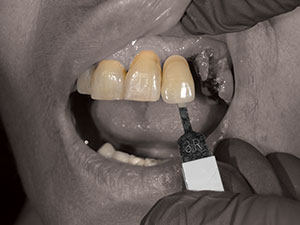
 |
| Figure 1. EasyShade V in action. |
 |
| Figure 2. EasyShade V LCD screen information. |
 |
| Figure 3. EyeSpecial C-II Isolate Shade mode. |
 |
| Figure 4. Taking a shade for ShadeWave. |
 |
| Figure 5. ShadeWave shade map. |
During the years, many shade-matching devices have come and gone. Issues are that with even the most sophisticated spectrophotometers, the tooth surface is not opaque like paint on a wall.
Shade matching of teeth is an art form more than an exact science. We have all sat there for a long time placing shade tabs next to a tooth and mumbling “too yellow/too dark/too light!” many times. And if there is a laboratory nearby, a patient may be sent off to let the technician figure it out. (Some labs actually come to the office.) Variations in color are affected by office lighting such as fluorescent, LED, incandescent, natural light, and more. Also, wall colors and even lipstick colors enter in to the shade-match game.
One simple idea is making sure that the lighting is uniform and correct. AdDent (addent.com) has the Rite-Lite 2 HI CRI Shade-Matching Unit, a device that “incorporates diffused LED technology to simulate various lighting conditions to aid in the matching of teeth.” A portable device, it illuminates the mouth with 3 lighting situations—5500°K, 3200°K, and 3900°K—that remove ambient light discrepancies. You simply shine the device on the area of interest and take the shade under these 3 lighting conditions with or without a polarizing filter.
During the years, many shade-matching devices have come and gone. Issues are that with even the most sophisticated spectrophotometers, the tooth surface is not opaque like paint on a wall. Montreal-based Cynovad had a great one, and Olympus had probably the best, allowing mapping, printouts, photos, and more. Alas, at a cost of about $7,000, it did not survive. XRite, the company that makes the devices for Home Depot, auto manufacturers, and others also seems to have dropped out.
VITA North America (vitanorthamerica.com) introduced the EasyShade in 2004, and it just keeps improving the product. Originally using the 16-shade A1 to D4, it now includes all these and the 3D-MASTER shade system. A simple design with a portable device, EasyShade allows you to map the tooth in as many areas as you care to, although typically it would be gingival, middle, and incisal using the 3-mm tip (Figures 1 and 2). With the latest configuration, the data can be sent wirelessly to an app and off to the dental lab. It is fast and simple to use.
Another popular method of shade communication with the lab is simply taking a photograph of the case with a shade guide in the photo. Even if you are sure of the color, it is best to send 3 images: one with the shade you chose, one with the tab just below, and one with the shade just above the one you picked. This is because cameras, computers, and monitors may not be exactly color-calibrated. In other words, the color on your screen might not exactly match the lab’s. This gives a guide as to how close the tab is to the actual tooth you are matching. Photographic shade matching is even better if you are using Shofu’s EyeSpecial C-II camera (shofu.com). In addition to its menu of settings for closeups, mirror shots, full face, and others, it has an amazing shade-matching setting. As you see in Figure 3, it grays out the soft tissue, highlighting the area you are looking at. I have personally found this to be a great function, and here is a quote from one of the labs I use: “We find the filtered photo to be helpful because we can see the shade and characteristics of the teeth better.”
But, as they say, that’s not all, folks. Dennis Braunston has been teaching dental photography for years. Additionally, his company Dental Learning Centers (dlcenters.com) has put together a dental camera kit that allows you to take images right out of the box (manual included). In the past few years, though, he has taken an old idea and now has software that will actually read the digital image of the teeth and figure out the shades. Even if the color of the camera or monitor is off, this works because you are taking a photo of the shade guide as well as a black, gray, and white tab with an A2 shade tab. The software can easily calibrate the shade since it “knows” black and white and A2 and can then extrapolate the colors. Here are some examples, shown in Figures 4 and 5. For more information, visit shadewave.com.
Also in Technology Today











